Market Insights
The silicon photonics market was estimated at USD 1.18 billion in 2021 and is likely to grow at a CAGR of 25.78% during 2022-2028 to reach USD 5.98 billion in 2028.
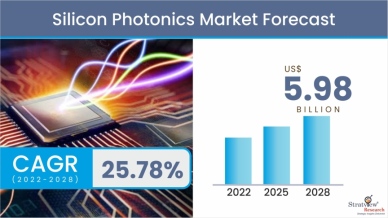
Want to know more about the market scope? Register Here
Market Dynamics
Introduction
Silicon Photonics is the application of photonic systems employing silicon as an optical medium. The silicon materials used in such photonic systems are deployed into micro photonic components as they are designed with sub-micrometer precision. The silicon photonics system functions at the wavelength of 1.55 micrometers comes under the infrared spectrum, and is most frequently used for optical communications.
Silicon Photonics is of different types, such as switches, transceivers, cables, sensors, and variable optical attenuators, that are used in various end-use industries, such as data centers, telecommunications, military & defense, and others.
Silicon photonics is transforming the landscape of optical communications by enabling high-speed data transmission with greater efficiency and reduced power consumption. This technology leverages silicon's ability to guide and manipulate light, facilitating the integration of photonic components with traditional electronic circuits on a single chip. As silicon photonics continues to advance, it promises to enhance the performance of data centers by increasing bandwidth and lowering latency.
Additionally, its applications extend beyond telecommunications to include emerging fields such as biomedical sensing and quantum computing. The ongoing research and development in silicon photonics are expected to drive innovation and expand its use across various industries.
Market Drivers
The key factors propelling the growth of the silicon photonics market are:
- The surge in demand for high-speed data transmission in data centers globally.
- Data is being transmitted between microchips using optical rays more and more frequently.
- The increasing demands for internet traffic and bandwidth reduction.
- The growing applications of silicon photonics in biomedical, autonomous vehicles, data transmission, telecom, and artificial intelligence, among other things, will contribute to the expansion of the silicon photonics industry.
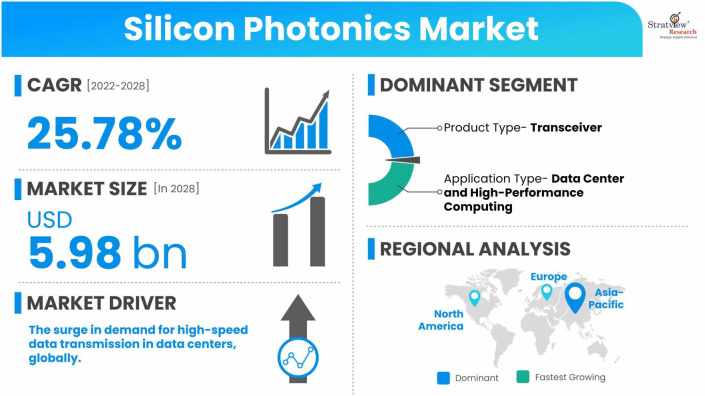
Want to have a closer look at this market report? Click Here
Key Players
The following are the key players in the silicon photonics market (arranged alphabetically):
- Acacia
- Broadcom
- Cisco
- Finisar
- GlobalFoundries
- Hamamatsu Photonics
- IBM
- Intel
- Mellanox Technologies
- STMicroelectronics
Note: The above list does not necessarily include all the top players in the market.
Are you the leading player in this market? We would love to include your name. Write to us at [email protected]
Segments Analysis
|
Segmentations
|
List of Sub-Segments
|
Dominant and Fastest-Growing Segments
|
|
Product-Type Analysis
|
Switch, Transceiver, Cable, Sensor, and Variable Optical Attenuator
|
The transceiver segment held the largest share of the market and is expected to remain dominant during the forecast period.
|
|
Application-Type Analysis
|
Data Center and High-Performance Computing; Telecommunications; Military, Defense, and Aerospace; Medical and Life Sciences; and Sensing
|
The data center and high-performance computing segment is expected to remain dominant during the forecast period.
|
|
Regional Analysis
|
North America, Europe, Asia-Pacific, and Rest of the World
|
Asia-Pacific is estimated to be the largest as well as the fastest-growing market for silicon photonics during the forecast period.
|
By Product Type
“The transceiver segment held the largest share of the market and is expected to remain dominant during the forecast period.”
The market is segmented as a switch, transceiver, cable, sensor, and variable optical attenuator. The Transceiver segment maintained its leading position in the market and is projected to continue its dominance throughout the forecast period.
The wide use of transceivers in data centers and high-performance computing, telecommunications, and military, defense, and aerospace is driving the growth of this segment.
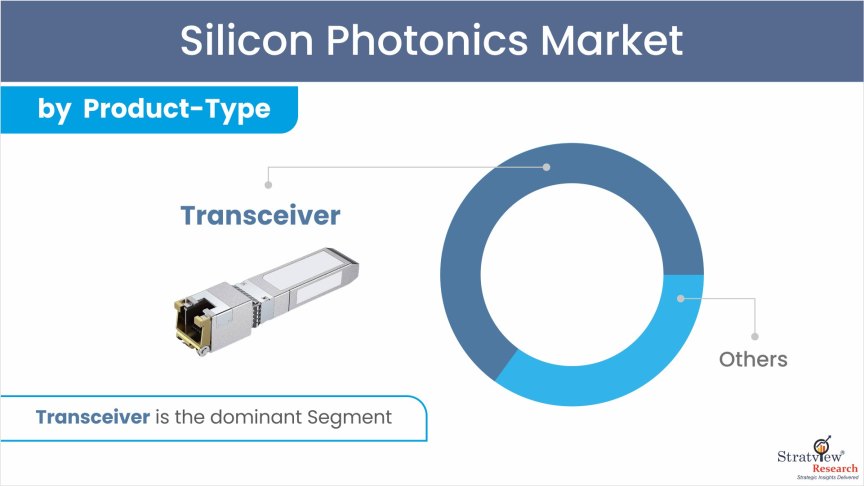
Want to get more details about the segmentations? Register Here
By Application Type
“The data center and high-performance computing segment is expected to remain dominant during the forecast period.”
The market is segmented into data center and high-performance computing; telecommunications; military, defense, and aerospace; medical and life sciences; and sensing. The data center and high-performance computing segment is projected to maintain its dominance throughout the forecast period.
With the surge in demand for cloud computing, there is an exponential increase in data traffic; various enterprises are shifting towards Software as a Service (SaaS) applications, which has led to an increase in demand for data centers globally.
Regional Insights
“Asia-Pacific is estimated to be the largest as well as the fastest-growing market for silicon photonics during the forecast period.”
In terms of regions, Asia-Pacific is forecasted to be both the largest and the fastest-growing market for silicon photonics throughout the projected period, with China, Japan, India, and Australia being the major countries with lucrative growth opportunities.
The growth of the market is driven by the growth of various end-use industries, such as data centers, telecommunications, military & defense, and others, which is generating huge demand for silicon photonics and the presence of a large number of players in the silicon photonics market in the Asia-Pacific region. North America and Europe are also expected to offer substantial growth opportunities during the forecast period.
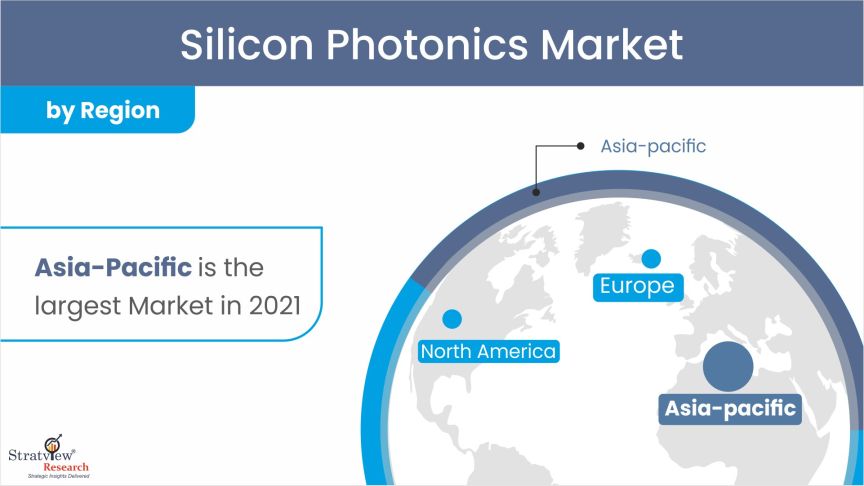
Know the high-growth countries in this report. Register Here
Research Methodology
This strategic assessment report, from Stratview Research, provides a comprehensive analysis that reflects today’s silicon photonics market realities and future market possibilities for the forecast period of 2022 to 2028. After a continuous interest in our silicon photonics market report from the industry stakeholders, we have tried to further accentuate our research scope to the silicon photonics market to provide the most crystal-clear picture of the market. The report segments and analyses the market in the most detailed manner to provide a panoramic view of the market. The vital data/information provided in the report can play a crucial role for the market participants as well as investors in the identification of the low-hanging fruits available in the market as well as to formulate the growth strategies to expedite their growth process.
This report offers high-quality insights and is the outcome of a detailed research methodology comprising extensive secondary research, rigorous primary interviews with industry stakeholders, and validation and triangulation with Stratview Research’s internal database and statistical tools. More than 1000 authenticated secondary sources, such as company annual reports, fact books, press releases, journals, investor presentations, white papers, patents, and articles, have been leveraged to gather the data. We conducted more than 15 detailed primary interviews with the market players across the value chain in all four regions and industry experts to obtain both qualitative and quantitative insights.
Report Features
This report provides market intelligence in the most comprehensive way. The report structure has been kept such that it offers maximum business value. It provides critical insights into market dynamics and will enable strategic decision-making for existing market players as well as those willing to enter the market. The following are the key features of the report:
- Market structure: Overview, industry life cycle analysis, supply chain analysis.
- Market environment analysis: Growth drivers and constraints, Porter’s five forces analysis, SWOT analysis.
- Market trend and forecast analysis.
- Market segment trend and forecast.
- Competitive landscape and dynamics: Market share, Service portfolio, New Product Launches, etc.
- COVID-19 impact and its recovery curve
- Attractive market segments and associated growth opportunities.
- Emerging trends.
- Strategic growth opportunities for the existing and new players.
- Key success factors
Market Segmentation
This report studies the market, covering a period of 12 years of trends and forecasts. The report provides detailed insights into the market dynamics to enable informed business decision-making and growth strategy formulation based on the opportunities present in the market.
The silicon photonics market is segmented into the following categories:
By Product Type
- Switch
- Transceiver
- Cable
- Sensor
- Variable Optical Attenuator
By Application Type
- Data Center and High-Performance Computing
- Telecommunications
- Military
- Defense, and Aerospace
- Medical and Life Sciences
- Sensing
By Component Type
- Active [Laser, Modulator, and Photodetector]
- Passive [Filter and Waveguides]
By Region
- North America (Country Analysis: the USA, Canada, and Mexico)
- Europe (Country Analysis: Germany, France, the UK, Russia, Spain, and Rest of Europe)
- Asia-Pacific (Country Analysis: China, Japan, India, South Korea, and Rest of Asia-Pacific)
- Rest of the World (Sub-Region Analysis: Latin America, the Middle East, and Others)
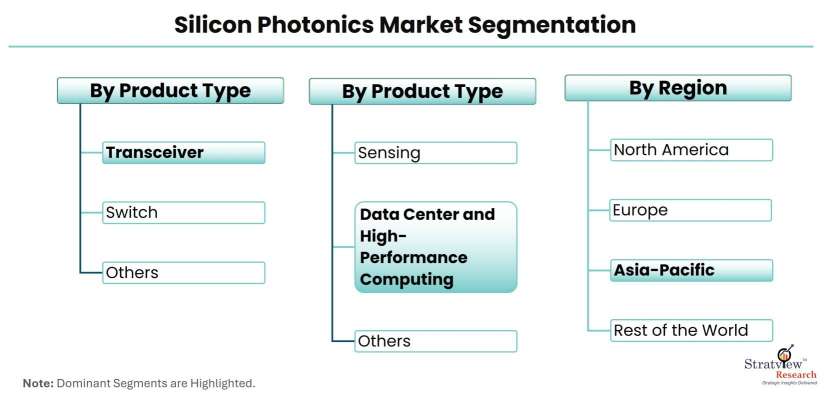
Click Here, to learn the market segmentation details.
Report Customization Options
With this detailed report, Stratview Research offers one of the following free customization options to our respectable clients:
Company Profiling
- Detailed profiling of additional market players (up to three players)
- SWOT analysis of key players (up to three players)
Competitive Benchmarking
- Benchmarking of key players on the following parameters: Product portfolio, geographical reach, regional presence, and strategic alliances.
Custom Research:
Stratview Research offers custom research services across sectors. In case of any custom research requirement related to market assessment, competitive benchmarking, sourcing and procurement, target screening, and others, please send your inquiry to [email protected].

